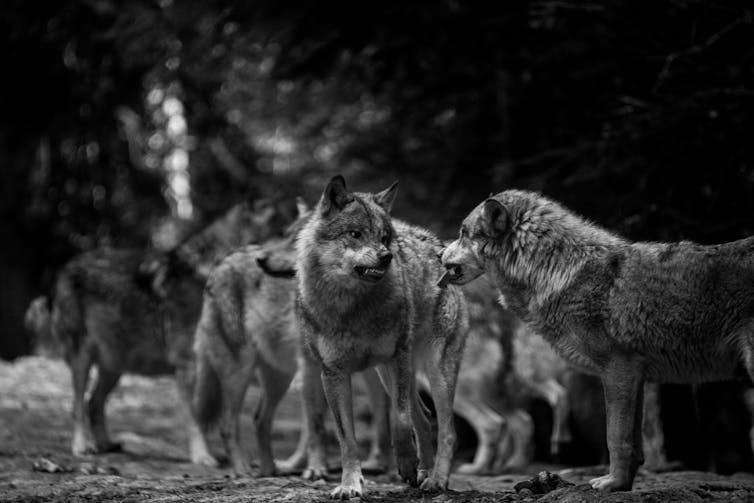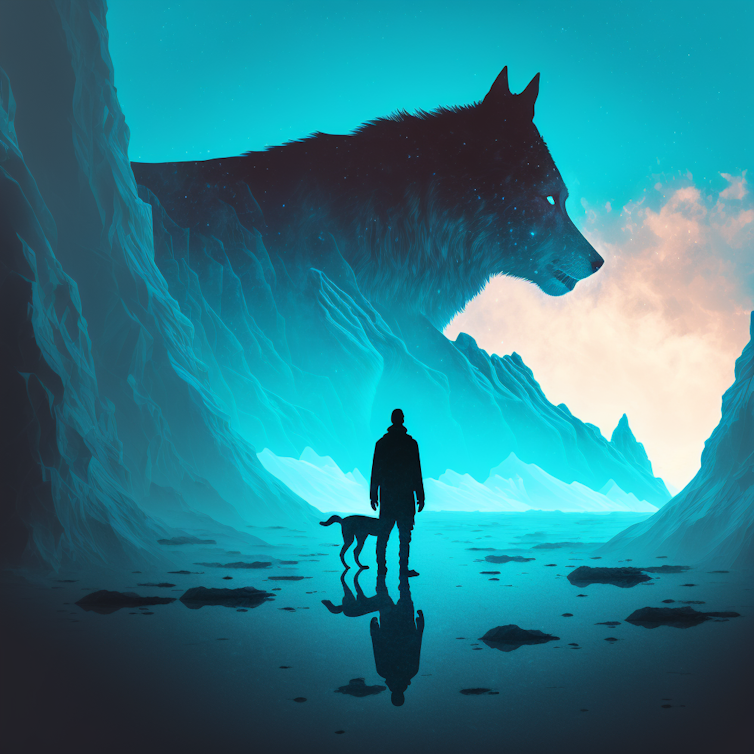Are dogs really descended from wolves?
Sitting comfortably on your sofa, you watch your dog sleeping peacefully next to you. Is he dreaming of his last bowl of kibble? Or perhaps he is imagining the great odyssey saga of his ancestors, who roam the vast steppes of the last “Ice Age” in herds in search of the reindeer that would be their next meal?
The story of the ancestral connection between the dog (the first animal to be domesticated) and the wolf is one of the most exciting evolutionary adventures in human history. Not only does it ask us about the relationship we have with the rest of nature, but it also refers us, by extension, to the question of everything we are as a human being.
The latest advances in genetics are beginning to provide key details that allow us to outline the related story of our loyal housemates and those proud wild canines that are gradually repopulating our countryside.
It was originally the wolf
Today the dog (Canis familiaris) is the most widespread carnivore on the planet. It has been part of our human adventure since the days when we were still nomadic hunter-gatherers, 20,000 or even 30,000 years before the invention of agriculture.
There are nearly 350 official dog breeds in the world and today there are nearly 7 million in French homes. If his faithful presence at our side has long been taken for granted, the dog is still a relatively recent element of human evolution. But the history and chronology of dog domestication are very complex and fuel both scientific debates, myths and other beliefs within our societies. To the question: “from which animal does the dog descend?” » most adults and children will answer without hesitation: « the wolf, of course! “Yes but now, which wolf are we talking about here?
The gray wolf (Canis lupuslisten)) is an apex predator found throughout the Northern Hemisphere. In other words, the wolf is a species that is at the top of the food chain, which actually has no natural predators, and which regulates the balance of its ecosystem through predation. Its origin is nebulous but certainly very ancient, and probably dates back to about 800,000 years ago. Wolves are genetically very diverse and about forty current subspecies have already been described.

Maxime Marimpoey
Despite the habitat restrictions and ecological niches created by man since prehistoric times, wolves are among the only large carnivores to have survived the mass extinction of the Late Pleistocene (between 50,000 and 10,000 years), thanks in particular to their great ecological resilience and to the flexibility of their predatory behavior. In the last two centuries the indirect pressures linked to urbanization and the numerous extermination campaigns have led to the almost total disappearance of its wild forms in Europe. But in recent years its presence is slowly recovering thanks to conservation programs. The gray wolf is currently reintroduced in our European countries together with 3 other species of carnivores: the brown bear, the boreal lynx and the wolverine.
Between dog and wolf
The chronology of the prehistoric domestication of the wolf is probably one of the hottest debates in evolutionary science. If paleontology obviously brings important components to this debate, the osteomorphological analyzes (the study of the dimensions and morphology of the bones) which are able to discriminate against proto-dogs remain difficult to identify.
We have known since the works of Charles Darwin that a series of phenotypic changes (observable physical characteristics) are observed in animals that undergo a domestication process, at least after many generations of carefully selected traits (often favoring the most docile). Over the millennia, domesticated canines have seen, for example, a reduction in the length of the snout and the size of the teeth, but also a reduction in the appendicular skeleton (fore and hind limbs). On the other hand, the isolated appearance of just one of these traits on a specimen cannot prove its domestic character. Therefore, either a series of significant variables must be observed on the same individual, or this new trait must be observed repeatedly on the scale of a given population or context. The problem is that complete skeletons of Paleolithic canids are extremely rare.

MNP/Thierry Le Mage)
In addition to this purely osteological approach, archeology thus comes into play to try to collect all the information relating to the first direct relationships between man and canine, information that could demonstrate a special bond that was beginning to be woven between these two forms of large predators from the upper Paleolithic (note for example the use of canines to make jewels, or its presence in wall art). But even in this case it is difficult to understand the true meaning of these scant clues.
Was the wolf the ancestor of the dog?
With the great advances that genetics has known in recent years, many ancient DNA studies are now coming to lend a hand to paleontologists and archaeologists who try to clarify the mystery of the origin of the “first dog”. Samples of ancient and modern canids are now being taken from all continents and the diversity of their gene pool is being analysed. The main advantage of this method is remarkable: perfectly preserved skeletons are not needed to obtain essential information, a simple bone fragment is sufficient. While most of these studies focus on mitochondrial DNA (DNA inherited only from the maternal line, but less prone to degradation), some, rarer ones, also concern the complete genome (therefore on chromosomes inherited from the maternal and paternal line, but which are preserved much less well during fossilization).
Thanks to these results, a picture of the global phylogenetic history of canids begins to emerge. And unsurprisingly, these analyzes reveal a very complex demographic and phylogenetic history of the gray wolf across the ages. In particular, they reveal that Paleolithic lupine populations had to adapt both to the changing geography of subsequent glacial events in Eurasia, but also to human presence which constantly modified their habitat. These environmental and ecological changes during the Quaternary led to expansion/shrinkage cycles of their populations, probably important demographic fluctuations and various fragmentations of their pool genetic.
Despite this, the information emerging from these analyzes is extremely exciting. The genetic divergence (i.e. the separation of a population into several distinct lineages) of modern Eurasian wolves is estimated to have occurred between 40,000 and 20,000 years ago. This would imply that the population of these Paleolithic wolves was highly fragmented during this period, which also corresponds to the Last Glacial Maximum (in other words, the “peak” of the Ice Age).

E.-L. Jiménez, Mid-journey
This date is all the more interesting as it coincides with the period during which homo sapiens migrates from the east and colonizes western Europe and where interspecific competition between large predators is strongly increasing.
Most interestingly, several studies agree that all modern Eurasian wolves are descended from a single small ancestral population that probably became isolated in Beringia (northeastern Siberia) during the last glacial peak, some 20,000 years, mainly to escape to the great climatic instabilities prevailing in the rest of Eurasia. This drastic “bottleneck” would give rise to a new lineage that would then recolonize the rest of the world. This replacement of the lupine population would likely have occurred at the expense of other forms of ancient wolves, then adapted to other forms of environment elsewhere in Eurasia. For this reason it would seem that all wolves today have a relatively “recent” common ancestor, or in any case no more ancient than the beginning of the Upper Paleolithic, about 36,000 years ago.
But the story thickens with the question of what domestic dogs look like. The complex history of the Eurasian gray wolf here hampers our quest to trace the dog’s exact origin. However, studies provide some key answers. A study of entire genome sequences of primitive Asian and African dogs, as well as a collection of samples from 19 different dog breeds from around the world, has identified that East Asian dogs have genetic diversity far greater than others . This modeling would show that the first dogs thus appeared in this region, after a divergence between the gray wolf and the domestic dog about 33,000 years ago. However, another genetic study in 2013 stated that the focus of domestication would rather have been Europe, somewhere between 32,000 and 19,000 years before present.
Finally, a third study that reconciles the first two hypotheses, proposes that wolf domestication occurred independently in East Asia and Europe, before primitive Asian dogs traveled west along with human populations where they replaced the dog population. autochthonous between 14,000 and 6,400 years ago. . Whatever the hypothesis, we can remember that when we see the first traces of sedentarization and the first techniques related to agriculture appear, around 11,000 years ago, at least five distinct canine lineages already existed, thus demonstrating that human societies had already profoundly modified the canine populations before the end of the Paleolithic.
And far from being compartmentalized, canid coevolution has never stopped. Even today the wolf continues to be the subject of hybridizations with other canids such as dogs, but also the coyote (Canis latrans) with which it is also interfertile.
In conclusion, even if the determination of the geographical origin of the domestic dog and the circumstances and chronology of its domestication still remain pending, advances in ancient DNA studies offer us today the means to follow the traces intertwined with these past and present canids. To the question “Do dogs descend from wolves?”, the answer is therefore yes, but genetics today offers us the means to clarify: modern dogs, however varied, all derive from a now extinct prehistoric wolf lineage, and in ultimately have only very distant ties to the modern wolf.


Commentaires
Enregistrer un commentaire